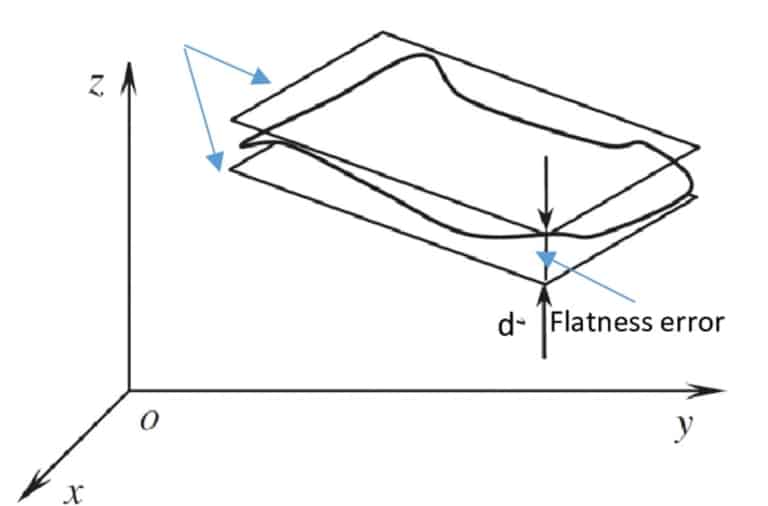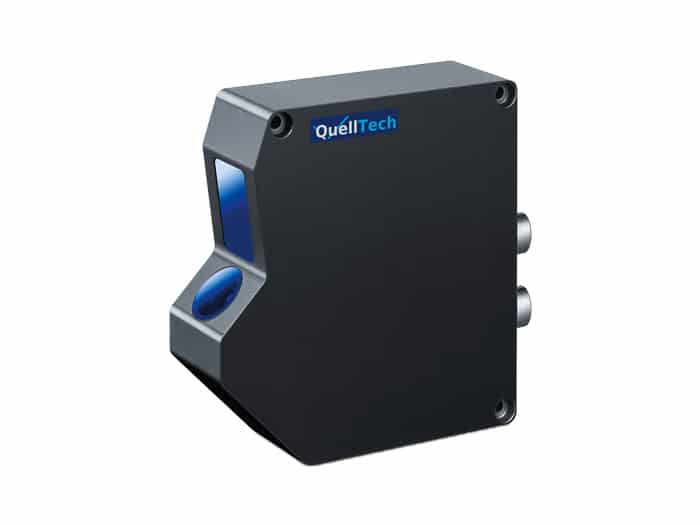Measuring the flatness of surfaces is of great importance in various applications. Some examples are the testing of sealing surfaces between two bodies, such as the cylinder head gasket in automobiles. Measuring flatness is also an important factor in the production of preliminary products in the metal industry, such as the production of axis guides for measuring systems, or in the production of wafers in the semiconductor industry.

Principle of flatness measurement of a surface
Flatness is the difference between the highest and lowest points of a surface located between two ideal flat (planar) surfaces. The distance between the two planar surfaces defines the flatness tolerance.
In the real world, flatnesses of a few nanometers can be achieved, e.g. for highly polished flat glass surfaces. For metallic measuring objects, which are manufactured in large quantities using the usual production methods, flatness tolerances of a few µm to a few tenths of a mm are common.
A surface is flat if it has no structures in its surface over its entire length and width.
There are optical (non-contact) or tactile methods for measuring a plane for planarity.
Optical chromatic confocal metrology uses the effect of different refraction of different wavelengths in glass.
Measurements with white light and laser interferometry uses the scattering behavior of reflected light to determine a surface structure.
In laser scanning, the optical measurement method used by QuellTech, a surface is continuously scanned with a laser line. The diffuse reflections of the laser line are recorded by a sensor. From the profile data recorded in this way, a computer can record a 3D point cloud of a scanned surface. Laser scanning as an optical measuring method is therefore particularly well suited for checking the surface flatness of starting material, profiles, rails and strip material.
The tactile scanning step method, on the other hand, performs the flatness measurement with the aid of a contacting measuring head. This measurement is very well suited for very small measuring distances where maximum precision is required. Since the probe head usually has a spherical shape with a certain diameter, it cannot plunge into any small valley of a few µm.
When measuring a flatness by the tactile 3D coordinate measuring method, it is necessary that a tactile contact of the surface with a measuring head is required.

3D point cloud of the flatness measurement of the surface at a sealing surface
QuellTech uses the laser scanning measurement method. Laser profiles with up to 4096 points per profile are recorded. Accuracies of up to 1-2 µm can be achieved.
In contrast to tactile measuring methods, it is possible to record several million measuring points in a few seconds on an area of e.g. 50 x 100 mm: Flatness measurement in highest precision.
This high number of measuring points enables a precise and complete recording of the flatness in a short time. The advantage over tactile measurement is that a laser light can penetrate the smallest surface structures.
Furthermore, the laser scanning method can also be used to measure coplanarity. For example, one laser scanner scans the top surface of a target and a second laser scanner simultaneously scans the same bottom surface of the target. In this way, the parallelism of these two surfaces to each other can be calculated.
The error messages can be set from alarm to plant stop. The 3D point cloud can be saved as useful documentation for quality assurance.
In the past, we have used Quelltech solutions for flatness measurement in a wide variety of projects. Here you can find a small excerpt of these projects:
The QuellTech Q6 Laser Scanner product series has a proven track record in demanding industrial applications that require high levels of precision, process stability and high travel speeds.
Further information: Q6 Laser scanner
The QuellTech Q5 laser scanner series combines advantages of small form factors with high resolution and fast scan rate. The Q5 is suitable for measurement applications with limited space and rugged environmental requirements.
Further information: Q5 Laser scanner

Q6 Laser Scanner

Q5 Laser Scanner
We are happy to help you with that!

Stefan Ringwald
Technical Consultant
If you have any questions about flatness measurement or would like a consultation from QuellTech on this subject, we will be happy to help.
We would like to help you to precisely evaluate your specific measurement task. Through an initial free test measurement of your application, we can give you an early assessment of the feasibility.
There is always potential for improvement, we will help you with that. Contact us for more information or to make an appointment for a consultation.
By submitting the contact form, you agree that your data will be used to process your request (further information and instructions on withdrawal can be found in the privacy policy).
Your technically competent contact, Stefan Ringwald, will be happy to help you.
Our aim is to fully understand your specific technical requirements for your current measurement task.
Thanks to many years of experience with complex tasks in the field of 3D laser measurement, you will receive well-founded solution proposals from us.